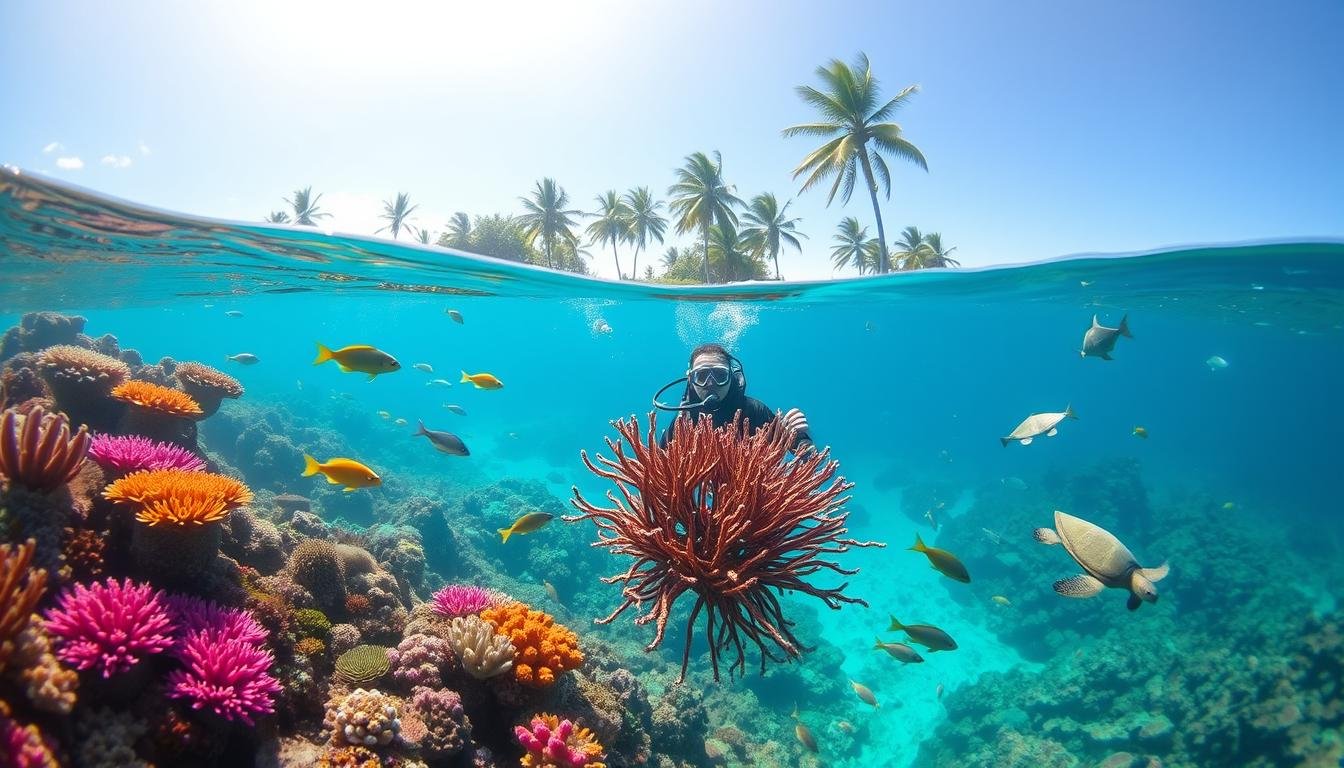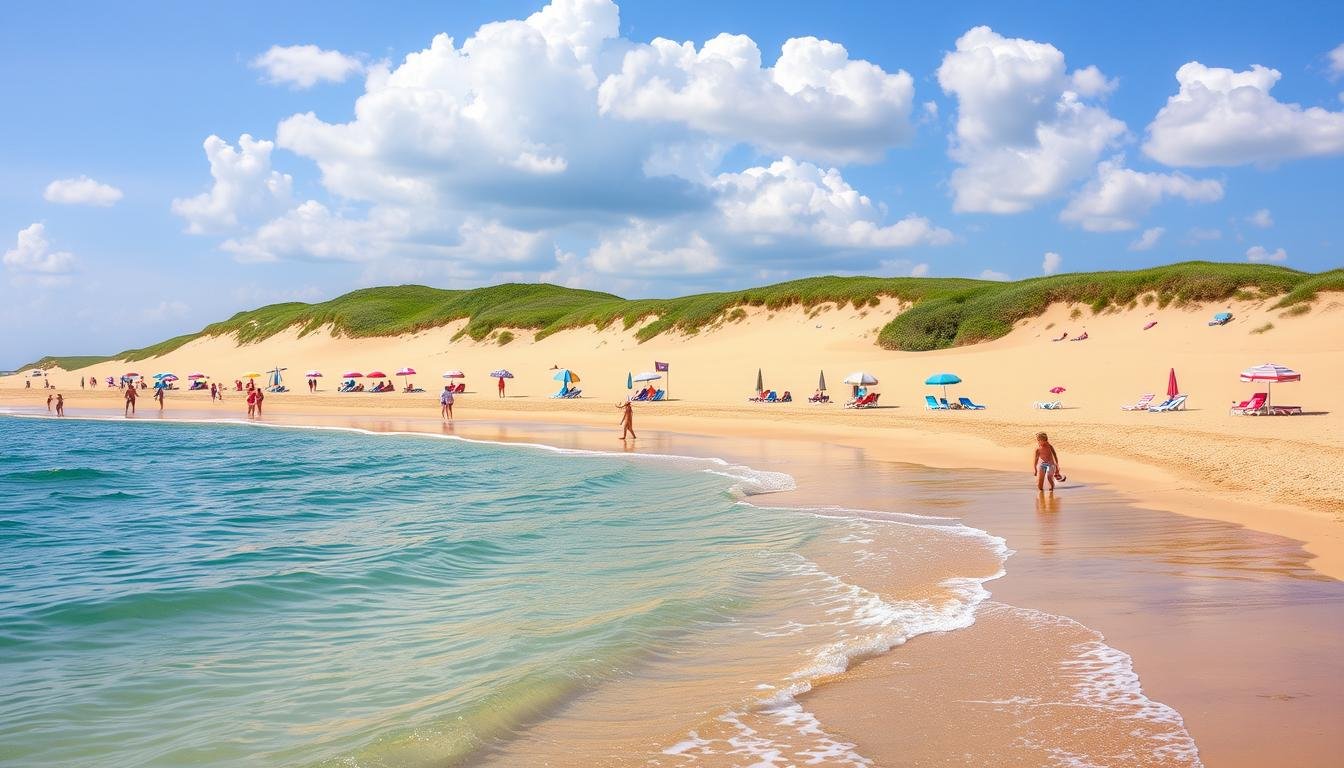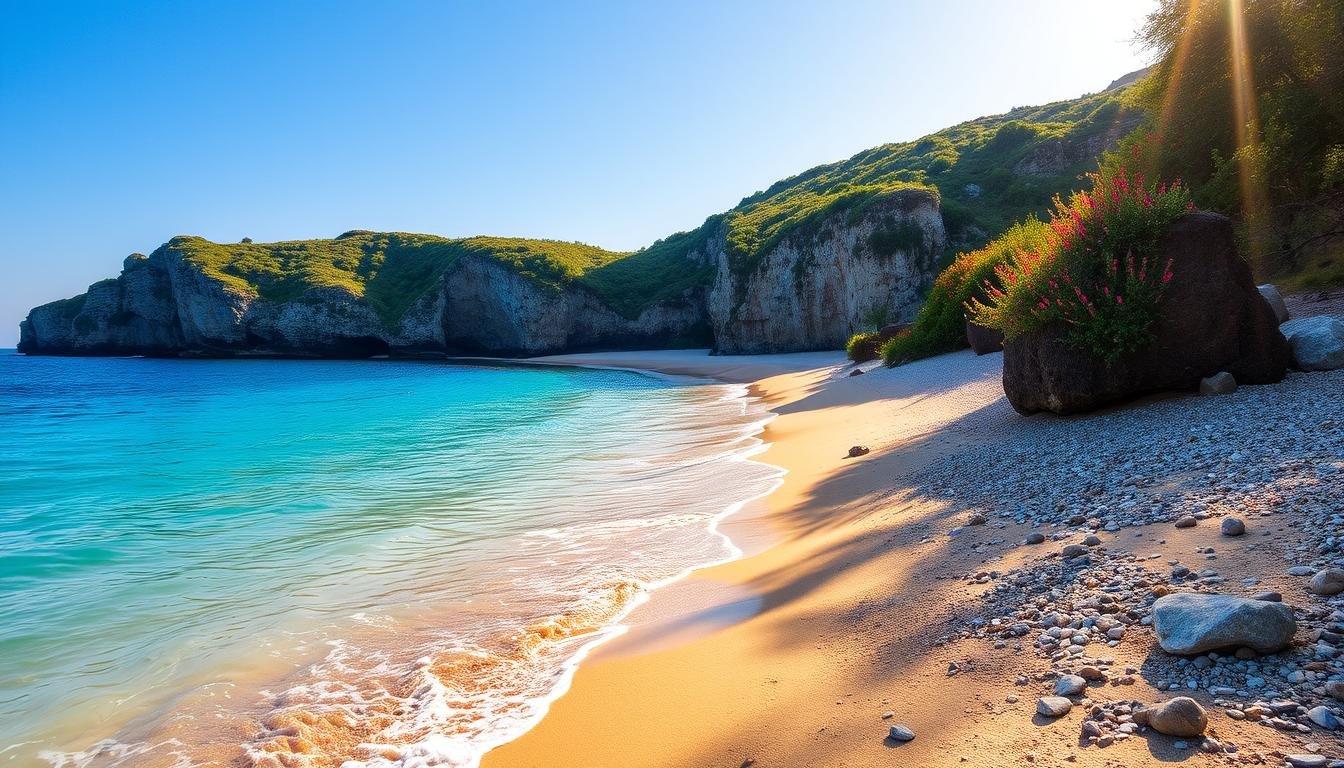Dive into a world of underwater wonders in Southeast Asia! This region is a scuba diver’s paradise. It boasts some of the most vibrant marine ecosystems on the planet. From the crystal-clear waters of Sipadan to the diverse coral reefs of Raja Ampat, you’ll find unparalleled diving experiences waiting to be explored.
Southeast Asia’s diving spots offer a kaleidoscope of marine life. Over 6,000 fish species and 75% of the world’s coral species call these waters home. Whether you’re a beginner or an experienced diver, the warm waters and stunning underwater landscapes promise unforgettable adventures.
Grab your underwater camera and prepare to capture the beauty of coral reefs teeming with life. From macro photography opportunities in Anilao to encounters with majestic manta rays in Komodo, each dive site offers unique experiences. The region’s diverse marine habitats cater to all interests, ensuring your logbook will be filled with incredible memories.
Key Takeaways
- Southeast Asia hosts 75% of global coral species
- Raja Ampat boasts the highest fish species count per dive
- Sipadan Island offers exceptional 50m visibility
- Tubbataha Reefs feature over 600 fish species
- Anilao is a top macro photography destination
- Lembeh Strait is known as the muck diving capital
- Most dive sites have specific peak seasons for optimal conditions
Understanding the Coral Triangle’s Marine Biodiversity
The Coral Triangle is a wonder of the sea. It covers 6 million square kilometers across six countries. It’s home to a vast array of marine life.
You’ll see vibrant coral and many different species. It’s a world full of life.
The Heart of Marine Life Diversity
Dive into the Coral Triangle and see why it’s special. It has 76% of the world’s coral species and over 6,000 fish species. It’s a haven for 6 out of 7 sea turtle species.
Species Distribution and Coral Formations
Every part of the Coral Triangle is unique. Raja Ampat in Indonesia has 1,500 fish species and 500 coral types. Lembeh Strait is famous for its black sand dive sites.
In the Philippines, Tubbataha Reefs Natural Park welcomes 13 whale species every year.
Conservation Efforts and Protected Areas
It’s important to protect this vital area. Efforts focus on creating marine protected sites and promoting sustainable practices. These actions help keep coral reefs healthy.
They also support the lives of 120 million people who rely on the Coral Triangle’s resources.
| Location | Notable Features | Conservation Status |
|---|---|---|
| Raja Ampat, Indonesia | 1,500+ fish species, 500+ coral species | Marine Protected Area |
| Tubbataha Reefs, Philippines | 360 coral species, 13 whale species | UNESCO World Heritage Site |
| Komodo National Park, Indonesia | Diverse marine life, unique terrestrial species | New Seven Wonders of the World |
Raja Ampat: Indonesia’s Crown Jewel
Raja Ampat is in West Papua, Indonesia. It’s a dream spot for divers. The area has 1,500 small islands and the richest coral reefs in the world.
It’s home to over 1,700 species of reef fish and 600 hard coral species. Raja Ampat has 75% of the world’s coral diversity.

The Dampier Strait is a key channel. It connects the Pacific Ocean and brings nutrient-rich waters. Cape Kri, in this strait, holds a world record with 284 fish species seen in one dive.
You’ll see amazing marine life like manta rays, sharks, and turtles. It’s a place full of wonder.
Misool Island is known for its stunning coral gardens. The Manta Mantra dive site is special, with up to 30 mantas at once. The Passage near Waigeo Island is also unique, filled with sea fans and colorful sponges.
“Raja Ampat is the heart of the world’s coral reef biodiversity. It’s a must-visit for any serious diver.”
The best diving time is from October to May. Liveaboards like MV Mermaid I and II offer great places to stay. Don’t forget to budget for park fees, which cost €225 to €275.
- Over 3,000 fish species
- 1,400 fish species in Raja Ampat alone
- 12 marine protected areas covering 3.6 million hectares
Raja Ampat’s marine sanctuary was set up in 2013. It covers four million hectares of coastal and marine waters. This protection means future generations can enjoy Indonesia’s underwater treasure.
Sipadan Island: Malaysia’s Diving Paradise
Sipadan Island is a top spot for diving in Malaysia. It’s a place where underwater lovers can find joy. The island’s coral gardens are home to many sea creatures.
Barracuda Point Highlights
Barracuda Point is famous for its barracuda schools. You’ll see them swirling in the water. The dive site’s wall drops over 600 meters, making it stunning.
Sharks, turtles, and octopuses are often seen here. They live in the rich waters.
Turtle Caverns Experience
Turtle Caverns is a special dive. It’s a maze under the sea where sea turtles rest. It’s a quiet place to see these creatures.
But, remember to be respectful. This is their home.
Permit Requirements and Regulations
Sipadan Island needs a special permit to visit. Only 120 permits are given out each day. This helps protect the sea life.
Book early to dive here. It’s a rare chance to see the underwater world.
| Diving Conditions | Details |
|---|---|
| Water Temperature | 79 – 86°F (26 – 30°C) |
| Visibility | 60-100ft (15-30m) |
| Depth Range | 16-131ft (5-40m) |
| Best Season | April to December |
Even though Sipadan is closed, nearby islands like Mabul and Kapalai are open. They offer great diving spots. You can explore different underwater worlds in Malaysia.
Komodo National Park: Where Dragons Meet the Sea
Komodo National Park in Indonesia is a dream for divers. It’s a UNESCO World Heritage Site covering 1,800 km² across 29 islands. The underwater world is as amazing as the dragons on land.
The park is in the Coral Triangle, with 76% of known coral species. It has over 1,000 fish species and 250 coral types. You can see manta rays, dugongs, and blue-ringed octopuses here.

Manta Alley is a must-see. From December to February, you might see 20 to 30 mantas in one dive! Other great spots include Batu Bolong and Crystal Rock, known for their vibrant reefs and strong currents.
Diving conditions vary in the park. Visibility is 10 to 40 meters, with water temperatures between 24-28°C. Strong currents make it exciting for experienced divers.
“Diving in Komodo is like nowhere else. The mix of big fish, colorful reefs, and underwater volcanic activity creates a unique experience.” – Local Dive Master
The best time to dive is April to June, after the monsoon. Calm seas and high visibility make it perfect. Many choose liveaboard trips for remote sites and night dives.
| Dive Site | Highlights | Difficulty |
|---|---|---|
| Manta Alley | Manta rays, reef sharks | Intermediate |
| Batu Bolong | Coral gardens, pelagics | Advanced |
| Crystal Rock | Schooling fish, strong currents | Advanced |
| Golden Passage | Drift diving, soft corals | Intermediate |
Remember, Komodo National Park isn’t just for diving. Don’t miss seeing the Komodo dragons on Rinca Island. It’s a rare chance to see these ancient creatures in their natural home.
The Similan Islands: Thailand’s Underwater Wonder
The Similan Islands in Thailand are a unique diving spot. This chain of nine tiny islands in the Andaman Sea is among the world’s top ten dive spots. The clear water and diverse marine life draw divers from everywhere.
Best Diving Seasons
Divers can visit the islands from October to May. For whale sharks and manta rays, go between December and April. During these months, the water is clear, letting you see the underwater wonders.
Marine Life Encounters
The Similan Islands are home to many marine creatures. You’ll see leopard sharks, reef sharks, batfish, moray eels, and barracudas. There are also shrimp-goby partnerships and colorful coral formations.
| Dive Site | Notable Features | Marine Life |
|---|---|---|
| Elephant Head Rock | Swiss cheese-like topography | Groupers, turtles, trevallies, reef sharks |
| Beacon Point | Healthy hard coral | Chromis, wrasse, parrotfish, surgeonfish |
| Boulder City | Strong currents, exposed location | Whale sharks, manta rays, Napoleon wrasse |
Diving Conditions and Requirements
The Similan Islands are good for all divers. Beginners can dive at Anita’s Reef, while advanced divers can try Christmas Point. The area has big granite boulders, making swim-throughs and canyons.
For a great experience, take a liveaboard trip. It lets you dive at many sites, like Richelieu Rock in the Surin Islands. Remember, new rules were put in place in 2018 to protect this place. So, book early.
Tubbataha Reefs Natural Park: Philippines’ Underwater Treasure

Tubbataha Reefs Natural Park is a treasure in the Philippines’ Sulu Sea. It’s a UNESCO World Heritage Site with high biodiversity. The park covers 100,000 hectares, offering a unique marine adventure.
The park’s ecosystem is home to many marine species. Over 600 fish and 300 coral species live here. Divers see large schools of barracuda and jacks, creating stunning views.
Tubbataha’s dive sites offer different experiences:
- North Atoll: Known for its diverse marine life
- South Atoll: Best spot for hammerhead shark sightings
- Jessie Beazley Reef: Offers impressive corals and chances to see tiger sharks
The park is more than beautiful. It’s a key nesting site for endangered turtles. The reefs also have the world’s highest white tip reef shark populations.
Getting to this paradise is only by liveaboard trips from March to early June. This limits access, helping to protect the ecosystem. For the best diving in the Philippines, Tubbataha Reefs is a must-see.
“Tubbataha Reefs Natural Park is a testament to nature’s artistry and the importance of marine conservation.”
Malapascua Island: Thresher Shark Heaven
Malapascua Island is a tiny paradise in the Philippines. It’s a top spot for scuba diving in Southeast Asia. This small island offers amazing shark diving experiences, attracting divers from all over.

Monad Shoal Diving Experience
Monad Shoal is the highlight of Malapascua’s diving. It’s one of the few places to see thresher sharks almost every day. Early morning dives here are unforgettable, with up to ten sharks seen in one dive.
Malapascua has more than 20 dive sites. Lighthouse is famous for its mandarin fish, while Chocolate Island is home to flamboyant cuttlefish and blue-ringed octopuses. Night dives show a magical underwater world.
Technical Requirements
Diving at Monad Shoal needs advanced skills. You must have a PADI Advanced Open Water or deep dive certification. Getting both certifications in five days makes Malapascua perfect for learning.
Getting to Malapascua is a 5-hour bus ride from Cebu City to Maya, then a 30-minute boat ride. The long journey is worth it for shark diving fans.
Tulamben: Bali’s Wreck Diving Destination
Tulamben is a small fishing village on Bali’s northeast coast. It offers amazing diving experiences. The main attraction is the USAT Liberty wreck, covered in coral and full of marine life.
This underwater paradise is just 40 meters from shore. It’s perfect for divers of all levels.
The Liberty wreck is huge, stretching 120 meters. It goes from 3 to 30 meters deep. You’ll see over 400 fish species here, making it a lively place.
Look out for surgeonfish, parrotfish, and even big creatures like Napoleon wrasse and eagle rays.

Macro photography fans will love Tulamben. The wreck is home to nudibranchs, pygmy seahorses, and frogfish. Night dives are special, with bioluminescent displays and rare creatures like transparent shrimps and squat lobsters.
| Dive Site | Distance from Shore | Depth Range | Notable Features |
|---|---|---|---|
| USAT Liberty Wreck | 40 meters | 3-30 meters | 400+ fish species, coral-encrusted structure |
| Seraya Secrets | Shore dive | 5-20 meters | Muck diving, rare macro life |
| Coral Garden | Shore dive | 3-12 meters | Vibrant reef, suitable for beginners |
Tulamben has volcanic sand beaches and shallow sites. It’s great for beginners and photographers. Most dive spots are less than 10 minutes away by boat. You’ll have time to see Indonesia’s underwater wonders.
Nusa Penida: Mola Mola Territory
Nusa Penida is a treasure in Indonesia, known for its clear waters and big marine animals. It’s a place where you can see the rare mola mola, or ocean sunfish.

Seasonal Marine Life Patterns
The waters around Nusa Penida get cooler from July to October. This is the best time to see mola molas. These huge fish, up to 10 feet long, come to Tanjung Benoa beach to eat plankton.
Crystal Bay is the best place to see mola molas.
Current Diving Techniques
Diving in Nusa Penida is challenging because of strong currents. To see mola molas, stay far away and be quiet. Take an underwater camera to capture their beauty.
Make sure you have the right gear and know how to dive before you go.
| Diving Aspect | Details |
|---|---|
| Best Season | July to October |
| Water Temperature | As low as 61°F (16°C) |
| Visibility | 30 to 70 feet (9-21 meters) |
| Key Marine Life | Mola mola, manta rays, reef sharks |
| Dive Site Depth | Up to 40 meters |
Nusa Penida’s underwater world is full of life, thanks to cold water from the Indian Ocean. You can see colorful coral reefs and manta rays cleaning themselves. Every dive here is a special adventure in Indonesia.
Essential Diving Certifications and Requirements
Diving certifications are key for exploring Southeast Asia’s underwater world. PADI courses guide you to become a skilled diver. The Open Water Diver course teaches you the basics for safe diving.
Course costs vary in the region. In Koh Tao, Thailand, expect to pay about 10,000 Baht. Gili Trawangan, Indonesia, charges around 5,500,000 Rp for Open Water courses. Malapascua Island, Philippines, costs about 19,500 Philippine Pesos.
For beginners, ‘Discover Scuba Diving’ costs $50-$100 USD. The full PADI Open Water Diver Course is $250-$300 USD. Advanced courses, like Deep Diver Specialty, are for experienced divers.
Dive safety is very important. Make sure you meet the requirements before taking advanced courses. For example, the Divemaster Qualification course needs an Open Water Dive Course and you must be 18 years old.
| Course | Approximate Cost (USD) | Duration |
|---|---|---|
| Discover Scuba Diving | $50-$100 | 1 day |
| Open Water Diver | $250-$300 | 3-4 days |
| Advanced Open Water | $200-$300 | 2-3 days |
| Specialty Courses | Varies | 1-2 days each |
Technical diving needs more training and experience. Always focus on safety. Choose well-known dive schools for your certifications.
Best Seasons for Southeast Asian Diving
Planning your dive trip to Southeast Asia? Timing is key! The diving season varies across the region. It’s influenced by monsoon patterns and marine life migration. Let’s dive into the best times to explore these underwater wonders.
Monsoon Patterns
Southeast Asia’s climate is ruled by monsoons. The dry season, from April to October, usually offers the most reliable diving conditions. But remember, each area has its quirks:
- Thailand’s west coast shines from November to April
- The east coast dazzles from May to October
Peak Visibility Periods
Clear waters make for unforgettable dives. Peak visibility often aligns with the dry season, but local currents can shake things up. Here’s a quick guide:
| Location | Best Visibility |
|---|---|
| Bali, Indonesia | April – October |
| Similan Islands, Thailand | February – April |
| Sipadan, Malaysia | April – June, September – November |
Marine Life Migration Seasons
Timing your trip with marine life migration can lead to magical encounters. Whale sharks and manta rays have their favorite seasons:
- Whale sharks in Triton Bay, Indonesia: October – December
- Manta rays in Raja Ampat, Indonesia: November – May
- Thresher sharks in Malapascua, Philippines: March – May
Remember, these are general guidelines. Local conditions can vary, so always check with dive centers for the most up-to-date information. Happy diving!
Diving Safety and Local Regulations
Scuba diving in Southeast Asia is all about safety. Learn the local rules and emergency steps before diving. Each country has its own diving laws, especially in marine parks.
For example, Tubbataha Reefs Natural Park in the Philippines only lets nine liveaboards dive. This is because the diving season is short, from February to June.
Respecting the ocean is key to diving safety. In Indonesia, you can dive all year, seeing many fish and coral types. Places like Tubbataha are home to over 600 fish species and 360 coral types.
Always listen to your dive guide, especially in areas with strong currents. Malapascua is famous for thresher shark sightings.
Don’t dive without dive insurance. It’s essential for your underwater trips. Whether you’re diving in Malaysia’s Perhentian Islands or Sipadan, you need it.
Water temperatures range from 24°C to 30°C. Visibility varies from 5 to 35 meters. Dive safely and enjoy the amazing marine life.



Leave a Reply